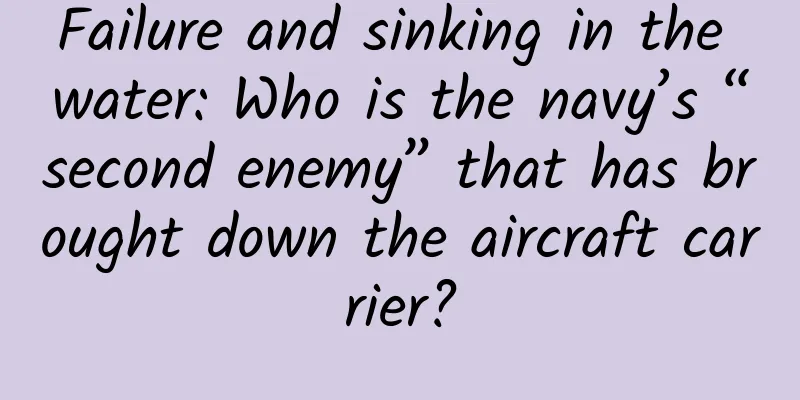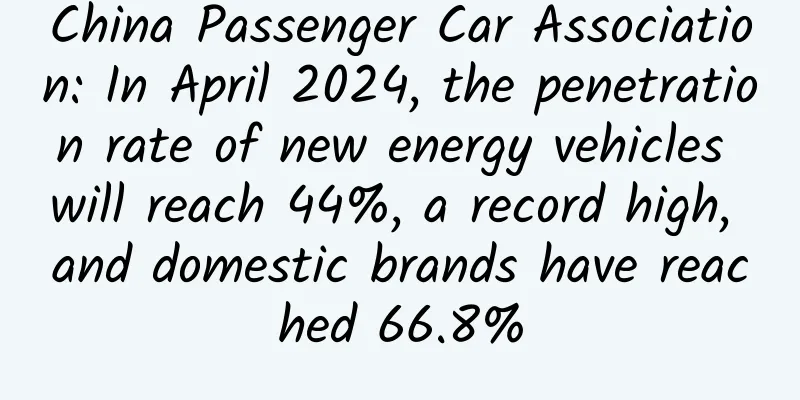Failure and sinking in the water: Who is the navy’s “second enemy” that has brought down the aircraft carrier?

|
On September 4, a piece of news about the loss of a "small formation" of the Russian Pacific Fleet, which made President Putin sleepless at night, became a hot topic in the media. In fact, the so-called "serious loss" of the Russian Navy by the media was just the impact of Typhoon "Mesak". An out-of-control floating dock at the Russian Navy shipyard collided with submarines and missile boats moored in the port. This incident once again aroused people's attention to the dangers and prevention of typhoons, the "second enemy" of the navy. Ships in the typhoon (Photo source: Phoenix.com) The naval fleet encountered typhoons and was repeatedly defeated Typhoons are always a nightmare that ships cannot get rid of. Before the navy had the ability to predict and forecast marine weather, the damage to ships caused by typhoons was very huge. There are records of naval forces being damaged by typhoons in my country for a long time: In June 598 AD (the 18th year of Kaihuang in the Sui Dynasty), Zhou Luohou crossed the sea from Donglai (now Laizhou, Shandong) to attack Pyongyang, and encountered a typhoon on the way. "Many ships were sunk, and eight out of ten died." Even after the establishment of the weather forecasting system, there are still many shipwrecks and deaths every year during the typhoon season. According to data, in the five years from 1979 to 1983, Japanese ships caused a total of 348 shipwrecks due to meteorological factors, 443 ships were damaged, and 972 people were injured or killed. Among them, shipwrecks caused by typhoons accounted for 75% of the total. After the 1996 Typhoon No. 9615 landed in Guangdong, the damage to ships in Zhanjiang Port was as follows: 34 ships were stranded, including 13 ships with a gross tonnage of more than 500 tons (excluding the large number of fishing boats and small boats stranded in the river fork); more than one-third of the ships broke anchor, and a considerable number of ships were damaged after being stranded and colliding with anchors; more than 60 large and medium-sized fishing boats capsized, 15 non-fishing boats, including 2 ships with a gross tonnage of more than 500 tons, and hundreds of small fishing boats and small boats sank; 18 light buoys were displaced or drifted away; a total of 97 bodies were salvaged in the port. In extreme cases, fleets including aircraft carriers also suffered devastating disasters due to the typhoon. In September 1935, the old Japanese Navy conducted an exercise, with the aircraft carriers "Hosho" and "Ryujo", the submarine carrier "Taikei", four Myo-kyo heavy cruisers, nine light cruisers such as "Mogami", "Fubuki" class destroyers, as well as the Kamikaze-class and Mutsuki-class destroyers, playing the role of the US "Fourth Fleet". On September 6, the "Fourth Fleet" encountered a typhoon, and the bows of two destroyers were cut off by large waves. The bridges of four destroyers and the decks of two aircraft carriers were severely damaged, cracks appeared on many warships, and 45 people died. Nine years later, in the Pacific battlefield, the US military suffered more severe typhoon damage than the Japanese. On December 18, 1944, in the waters east of Luzon Island, the 38th Task Force of the US Navy, consisting of 13 aircraft carriers and more than 70 warships, encountered the Typhoon "Cobra" with a wind force of up to 17. In this typhoon shipwreck, three destroyers sank, 26 ships including aircraft carriers were severely damaged, and three aircraft carriers caught fire due to collisions in the hangar. Two of the aircraft carriers were damaged to the point of being scrapped, and the escort aircraft carrier "Kasan Bay" was cut in two by the typhoon. In addition, 146 carrier-based aircraft were scrapped or directly blown into the sea, and 790 crew members died or were missing. From then on, the US Navy called the typhoon another enemy in naval battles. In the history of human naval warfare, there have been cases where the battle situation was changed and even the fate of a country was affected because of a typhoon attack on the fleet. On the night of October 20, 1274, the Mongolian army, which consisted of more than 450 warships and more than 33,000 people, was attacked by a typhoon and heavy rain in the Battle of Hakata Port, Japan. More than 200 Yuan warships collided with rocks or ran aground, and more than 13,500 officers and soldiers fell into the sea and died. In the spring of 1281, Kublai Khan sent nearly 100,000 troops to Japan again. A typhoon that lasted for two days attacked the Yuan fleet and destroyed most of the ships. The typhoon not only caused the Yuan army's expedition to Japan to suffer heavy casualties, but also freed Japan from the threat of the Yuan army, thus planting the belief that the "divine wind" would protect it. The five major elements of a typhoon cause wind and waves that endanger ships Typhoons are accompanied by strong winds, heavy rains and huge waves during their movement. Some people vividly call them "the whip of the sea god". Traditionally, people generally refer to tropical cyclones of different levels as typhoons. Preventing tropical cyclones from causing disasters to ships is referred to as wind and typhoon prevention or typhoon resistance. In fact, whether it is an aircraft carrier with a displacement of tens of thousands of tons or a ship of hundreds or thousands of tons, they all seem so small and helpless in front of a typhoon. The harm of typhoons to ships is mainly reflected in the five most direct factors. The rotating wind that can draw ships into the center of the typhoon. The rotating wind is the power source of the typhoon's powerful destructive force. The base of a mature tropical cyclone is approximately circular, with a diameter of 300 to 500 nautical miles (1 nautical mile is about 1.85 kilometers). The average diameter of the strong wind area above level 8 is about 300 nautical miles, and the average diameter of the strong wind area above level 12 is about 80 nautical miles. The larger the hull area exposed above the water surface, the stronger the wind, the greater the pressure on the hull, causing the ship to drift and rotate uncontrollably, changing the original state of motion and route, and then causing collisions, groundings, reefs, and even capsizing. The 15,556-ton roll-on/roll-off passenger ship "Estonia" was sailing in the Baltic Sea on February 28, 1994. Due to a strong typhoon, the bow hatch cover was damaged, loosened, and fell off, and a large amount of seawater poured in, causing the ship to capsize and sink, killing more than 820 passengers and crew members. Strong wind pressure can also destroy the hull structure, damage the equipment on board, and cause disasters such as hull rupture, water ingress, power outage or fire. If the ship is improperly operated during a typhoon, it will be swept into the center of the typhoon by the strong wind, which is very likely to cause a shipwreck with casualties. As we all know, the characteristics of landing ships and passenger and cargo roll-on/roll-off ships are shallow draft, tall and wide hulls, and much larger wind-exposed areas than other ship types. When encountering a typhoon, the damage caused by wind pressure is naturally greater, and the probability of capsizing and sinking is correspondingly high. On July 14, 2020, the Indonesian Navy's "Tek Yakta" tank landing ship encountered a typhoon, the hull was damaged and leaked, and it sank in the waters of Conn Island in East Java. The situation of the floating dock when empty is similar to that of the landing ship. Under the same wind force, it is easy to break the anchor and break the cable and lose control. This is also a major reason why the Russian Pacific Fleet submarines and missile boats were "lying and hit" in the port. Super strong swells that want to compete with typhoons in destructive power. Swells are more destructive to ships than wind. Data show that when the wind force reaches level 8, the wave height of the swell can reach more than 5 meters. The closer to the center of the typhoon, the greater the wave height of the swell. In typhoon areas with wind force of more than level 12, the maximum wave height is more than 15 meters. In August 2017, when Typhoon "Hato" passed through the central and eastern parts of Guangdong and the northern waters of the South China Sea, swells of 6 to 10 meters appeared, and 6 observation stations experienced high tides that exceeded the highest historical level and once in a hundred years. It is calculated that the crushing pressure of a 12-meter-high swell is about 6,000 kg/square meter. The larger the ship and the closer it is to the center of the typhoon, the greater the impact of the swell. Generally speaking, the longer the typhoon lasts, the more swells are generated and the greater the height of each wave. When several swells interact with each other, a super-large swell will be generated. Continuous swells of varying sizes can cause fatal damage to ships sailing or at anchor, as well as facilities such as ports and docks. What is even more terrifying is that if the wavelength of the swell is close to the length of the ship, once the bow and stern are at the crest of the wave at the same time and the middle of the ship is at the trough, the swell will lift the ship from both ends and the ship may break from the middle of the keel. US aircraft carrier swaying in the typhoon (Photo source: Baidu Pictures) Strange waves that will tear ships apart. In typhoon-ravaged seas, under the combined influence of terrain, ocean currents, water depth, wind direction and other factors, swells from distant sea areas will meet swells in the opposite direction of the sea area. Although the wave speed decreases after the collision of several swells, the wave height will suddenly double, forming "triangular waves". Once a giant "triangular wave" is formed, the waves in the sea area will surge up and down, horizontally and vertically at the same time, like mountains surrounding them without a definite direction. Ships trapped in it will jump up and down, sway left and right as if they had taken "ecstasy", causing the hull to twist and deform, the structure to break and even break. During a visit, a destroyer and frigate formation of our navy encountered "triangular waves" in the Bay of Bishikai in the western Pacific. Fortunately, the domestic destroyer withstood the test. In the early morning of March 12, 1934, the 500-ton torpedo boat "Tomozuru" of the former Japanese Navy encountered a "triangular wave" and was overturned and capsized in the sea. 72 crew members drowned, 28 were missing, and only 13 survived. In the two typhoon shipwrecks of the former Japanese Navy's "Fourth Fleet" and the US Navy's 38th Task Force, there were also cases where large ships were twisted or had their keels broken by "triangular waves". The bow of the US Navy CA-72 "Pittsburgh" heavy cruiser was "cut off" by the triangular waves created by Typhoon "Connie". Heavy rain and storm surges can seriously reduce visibility. Because of the extremely warm and humid air, the arrival of typhoons also means the dangers of heavy rain and storm surges. According to statistics, when a typhoon lands, the precipitation in the central area of the rain can reach 100 to 300 mm, and locally 500 to 800 mm. The water increase brought by a strong typhoon can cause the coastal water level to rise by 4 to 5 meters, overflowing the flood control dike and causing damage to port facilities and ships. Heavy rain can also seriously reduce visibility at sea, making it very difficult to visually observe the ship's position and visual communication. The navigation radar also reduces its ability to observe sea targets due to the increase in clutter such as waves, and the difficulty of ship manipulation and deck operations increases, making it very easy to have collisions, groundings, people falling into the water or injuries. On January 26, 2018, the Iranian Navy's "Damavand" destroyer encountered a typhoon and storm surge near the coast of the Caspian Sea and ran aground on the breakwater near the Anzali military port. Secondary disasters often cause chain reactions that aggravate the damage. "When the city gate is on fire, the fish in the pond are affected." There are many cases of secondary or tertiary disasters caused by typhoons to ships or fleets. The submarine and missile boat accidents mentioned at the beginning of the article are typical secondary disasters caused by typhoons. In June 1945, Halsey's fleet was hit by a typhoon for the second time. The US warships assembled in Buckner Bay collided with each other, ran aground and hit reefs. A total of 12 warships sank, 222 warships ran aground, 32 warships were severely damaged and almost beyond repair, nearly 200 aircraft were destroyed, and 107 amphibious landing ships were stranded or damaged. When Typhoon Nesat passed through Taiwan on July 30, 2017, two Taiwanese frigates were also damaged by collisions with out-of-control civilian ships. That night, because the stern cable was broken by the typhoon, the "Lina" ship, which was anchored at the East Third Pier of Keelung Port, first hit the port side stern of the "Lan Yang" ship, causing water to enter, and then collided with the "Huai Yang" ship, causing the stern of the ship to be dented and deformed and five railings on the rear section of the port side of the main deck to be broken. Ships in a typhoon The eight ships crossed the sea to take precautions against typhoons and take shelter from winds In order to prevent and defeat typhoons, our common second enemy, the navies of various countries have built high-quality ports with complete navigational facilities, windproof anchorages, ship mooring equipment and other ship mooring and anchoring systems on the basis of accurate monitoring of typhoon movements. They have also established a very strict set of typhoon prevention and sheltering standards, and achieved good results in typhoon prevention and sheltering practices. Make great efforts to improve the level of meteorological support. The grim facts have made people realize that early evacuation is the first option for ships to prevent typhoons, and accurate weather forecasts have become an important part of the sea support for navies of various countries. The US Navy, which has suffered a great loss, attaches great importance to the construction of meteorological support, and is equipped with sufficient professional meteorological personnel. It is particularly willing to spend a lot of money on the construction and equipment of meteorological satellites, meteorological stations, sounding balloons, airships, and aircraft, and has achieved sufficient early forecasts of typhoons. my country actively develops and uses new unmanned detection equipment, which has played an important role in the accurate forecast and timely warning of typhoons. On the morning of August 1, the semi-submersible solar meteorological detection unmanned boat developed by the Chinese Academy of Sciences successfully passed through the center of the 2020 No. 3 typhoon "Shanlak", and obtained detailed data on high-temporal resolution ocean surface meteorology and ocean elements during the development of the typhoon. This is the first time in the world that a solar unmanned boat has been used to actively approach and detect the center of a typhoon. With the development of military meteorology and the use of meteorological satellites, marine meteorological forecasts can better grasp the whereabouts of typhoons, enabling ships to organize typhoon prevention operations in a planned manner. Carefully organize typhoon prevention according to typhoon warnings and paths. In order to minimize typhoon damage, our navy has stipulated the corresponding typhoon warning levels and the corresponding typhoon prevention actions of the crew. After receiving the wind warning, the fleet or ship should determine the typhoon prevention measures according to the location of the ship and the possible path of the typhoon, and actively carry out typhoon prevention. When a ship encounters a typhoon at sea, it should determine the position of the ship, determine the avoidance method, and correctly change the course and speed according to the typhoon situation and dynamic forecast, as well as the wind force, wind direction and air pressure data observed on site, to ensure that the ship's position is outside the typhoon range of the wind force level that the ship can resist. When a ship is sailing in the wind, methods such as pressurizing the cabin water should be adopted to lower the center of gravity of the ship, keep the ship watertight, reduce the free liquid surface, prevent the occurrence of main engine overload, cable short circuit, cabin flooding, etc., and avoid the ship being affected by the wind laterally and the resonance between the ship's swing cycle and the waves. When the typhoon has little impact on the ship's station, the pier can be used for typhoon prevention. The focus of this method is to prevent the ship from directly colliding with the pier and causing damage to the ship. Measures such as mooring multiple cables to reinforce the pier, stabilizing the outer anchor chain, and adding fenders to buffer collisions can be taken. Under normal circumstances, ships are not allowed to dock to avoid mutual collision and squeezing. At the same time, the ship must be replenished with sufficient oil, water, and supplies, and all equipment systems must be checked and kept in good condition. When a typhoon has a significant impact on the station, measures should be taken to prevent typhoons at anchorages. Anchorages with good windbreaks should be selected to drop anchor or tie water drums for typhoon prevention. The anchorages should have mountains, islands or other barriers to effectively reduce the power of typhoons. The anchorages should be located on muddy or sandy bottoms where the anchors can be firmly anchored. When tying water drums, the ships should be connected to the water drums with anchor chains and steel cables at the same time. The anchorage area should be relatively open, leaving room for emergency maneuvers to be able to raise anchors at any time. Preparations should be made for possible collisions and grounding accidents caused by broken anchor chains and dragging anchors during typhoon prevention at anchorages, and a certain safe distance should be maintained between ships. If a collision occurs due to dragging anchors or broken cables, the spare anchors should be dropped immediately, or the ship's power system should be used to ensure that the ships do not run aground, hit a reef or collide. When a typhoon directly lands at the station, mobile typhoon prevention should be adopted. Mobile typhoon prevention in the sea area is currently the most commonly used way to avoid the wind. According to the typhoon warning information, appropriate routes should be planned in advance to avoid the typhoon's path and move to the sea area with less typhoon impact as quickly as possible to avoid the wind. In October 2019, the ships of various countries participating in Japan's "Fleet Review" moved to relatively safe waters in advance to avoid Typhoon "Haibei". The "Taiyuan" ship of the Chinese Navy left Yokosuka in the afternoon of October 10, sailed southwest of Honshu Island, and arrived safely in the waters near Osaka Bay on the 11th for mobile typhoon prevention. For submarines, typhoon prevention and wind shelter work is more important and complicated. Due to the relatively slender submarine type and the limited anchoring and mooring equipment of the hull, submarines usually do not use dock mooring and anchoring to prevent typhoons. Under normal circumstances, submarines, especially nuclear-powered submarines, enter submarine caves or special docks to avoid typhoons when typhoons come. During the voyage or in extreme weather conditions, submarines can take underwater typhoon prevention or sit on the seabed to prevent typhoons and wind shelter. According to wave theory and measured data, the greater the submarine dives, the smaller the impact of waves; when the diving depth reaches more than 1/2 of the wavelength of the sea surface waves, the impact of waves can be ignored. Therefore, when the sea is deep enough, the submarine can dive to a depth of about 100 meters underwater and sail out of the typhoon strong wind area at an underwater speed of 3-4 knots. In unfavorable conditions such as insufficient submarine power and fresh water, it can take the method of sitting on the seabed to avoid typhoons. At this time, special attention should be paid to prevent mud and sand from depositing around the submarine hull due to ocean currents and horizontal movement of water molecules. The submarine can be floated 2-3 times a day and night to prevent it from being trapped by mud and sand due to staying on the bottom for too long. |
<<: Dust and noise are too loud. Can planting green plants reduce noise? Cedar: Watch me do it!
Recommend
A complete and effective event planning plan!
Event planning refers to the planning of differen...
Xplay 3S battery life test results released
Recently, vivo officially released a battery life ...
Mastering "user thinking" is a necessary quality for Internet product operators
Today is an era where users and traffic are king....
The mysterious LeTV shareholders meeting: there were more security guards than shareholders attending the meeting
LeTV (300104) held its first extraordinary genera...
Let’s talk about the process of the project from 0 to 1
As the saying goes, there are more projects and m...
Why isn’t your Tik Tok recommended? A guide to avoiding pitfalls on Tik Tok!
Three quarters of 2018 have passed in the blink o...
Is it safe to promote Baidu framework accounts opened by Baidu branches and Baidu headquarters?
To enter Baidu, you need to understand Baidu comp...
After four years of Western blockade, the company is still the king after returning. The star-magnitude flash technology makes it truly "far ahead".
A great man once said that China opposes sanction...
Where is the way out for nine out of ten online variety shows that are star-studded?
As soon as the summer comes, major TV stations an...
WeChat's biggest competitor is coming! The three major operators are all working on 5G, and news is coming soon
5G messaging, which is regarded by the industry a...
MOTO 360 second generation has upgraded performance and battery life
Unlike the Android-powered Nexus, Google has not ...
Why do we have multiple languages in our dreams?
© Emmanuel Lafont Leviathan Press: I remembered a...
What to eat during space travel? Artificial food may become the mainstream in the future
As the saying goes: "Three meals a day, life...
Unpopular and side business projects that can make huge profits. What are some good unpopular business projects?
What is the most valuable thing on the Internet? ...









